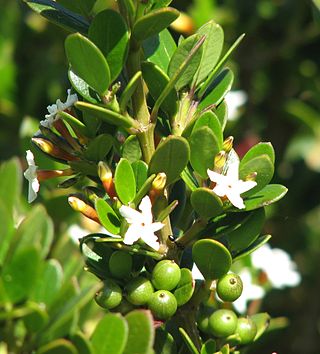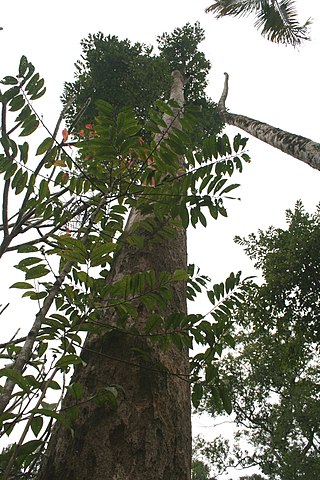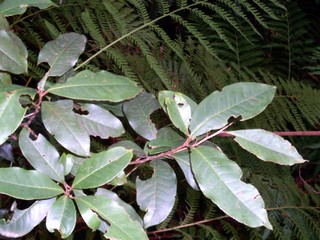
Alyxia is an Australasian genus of flowering plant in the dogbane family, Apocynaceae. It contains at present 106 species, but Alyxia stellata and A. tisserantii are very variable, might be cryptic species complexes, and are need of further study. It consists of shrubby, climbing or scrambling plants. This genus occurs in China, the Himalayas, Southeast Asia, Australia, New Caledonia and the Pacific Islands. There are 14 species in Australia, 21 in New Caledonia and 7 in the other Pacific Islands, including Hawaiʻi.

The Sapotaceae are a family of flowering plants belonging to the order Ericales. The family includes about 800 species of evergreen trees and shrubs in around 65 genera. Their distribution is pantropical.

Palaquium is a genus of about 120 species of trees in the family Sapotaceae. Their range is from India across Southeast Asia, Malesia, Papuasia, and Australasia, to the western Pacific Islands.

Cordyline is a genus of about 24 species of woody monocotyledonous flowering plants in family Asparagaceae, subfamily Lomandroideae. The subfamily has previously been treated as a separate family Laxmanniaceae, or Lomandraceae. Other authors have placed the genus in the Agavaceae. Cordyline is native to the western Pacific Ocean region, from New Zealand, eastern Australia, southeastern Asia and Polynesia, with one species found in southeastern South America.

Pouteria is a genus of flowering trees in the gutta-percha family, Sapotaceae. The genus is widespread throughout the tropical Americas, with outlier species in Cameroon and Malesia. It includes the canistel, the mamey sapote, and the lucuma. Commonly, this genus is known as pouteria trees, or in some cases, eggfruits.

Niemeyera is a genus of plants in the family Sapotaceae described as a genus in 1870. The entire genus is endemic to Australia. Its closest relative is Pycnandra from New Caledonia.
- Niemeyera chartacea(F.M.Bailey) C.T.White - Queensland
- Niemeyera prunifera(F.Muell.) F.Muell. - Queensland
- Niemeyera whitei(Aubrév.) Jessup - Queensland, New South Wales

Beilschmiedia is a genus of trees and shrubs in family Lauraceae. Most of its species grow in tropical climates, but a few of them are native to temperate regions, and they are widespread in tropical Asia, Africa, Madagascar, Australia, New Zealand, North America, Central America, the Caribbean, and South America. The best-known species to gardeners in temperate areas are B. berteroana and B. miersii because of their frost tolerance. Seeds of B. bancroftii were used as a source of food by Australian Aborigines. Timbers of some species are very valuable.

Bikkia is a genus of flowering plants in the family Rubiaceae. It is native to the Philippines, the Maluku region of eastern Indonesia, New Guinea and the western Pacific. The genus was named by Caspar Reinwardt in 1825. Seven of the New Caledonian species previously included in Bikkia were transferred to a separate genus, Thiollierea, in 2011 based on molecular and morphological information.

Madhuca is a genus of plants in the family Sapotaceae first described as a genus in 1791.

Melodinus is a genus of plant in the family Apocynaceae, first described as a genus in 1776. It is native to Indomalaya, Meganesia and various islands in the western Pacific. A type of monoterpenoid indole alkaloids called melodinines can be isolated from Melodinus plants.

Ochrosia is a genus of flowering plants, first described in 1789. It is in the family Apocynaceae, native to Southeast Asia, Australia, and various islands of the Indian and Pacific Oceans.
- Ochrosia ackeringae(Teijsm. & Binn.) Miq. – Indonesia, Philippines, Papuasia, Christmas Island
- Ochrosia acuminataTrimen ex Valeton – Sulawesi
- Ochrosia alyxioidesGuillaumin – Vanuatu
- Ochrosia apoensisElmer – Luzon, Mindanao
- Ochrosia balansae(Guillaumin) Baill. ex Guillaumin – New Caledonia
- Ochrosia basistaminaHendrian – Sulawesi
- Ochrosia bodenheimarumGuillaumin – Vallée de la Toutouta in New Caledonia
- Ochrosia borbonicaJ.F.Gmel. – Mauritius + Réunion; naturalized in Guangdong
- Ochrosia brevitubaBoiteau – New Caledonia
- Ochrosia brownii(Fosberg & Sachet) Lorence & Butaud – Nuku Hiva in Marquesas
- Ochrosia citrodoraK.Schum. & Lauterb. – New Guinea
- Ochrosia coccinea(Teijsm. & Binn.) Miq. – Maluku, Sulawesi, New Guinea, Solomon Islands; naturalized in Guangdong
- Ochrosia comptaK.Schum., Hōlei – Hawaii
- Ochrosia ellipticaLabill. – Lord Howe Island, Queensland, New Caledonia, Vanuatu, Nauru; naturalized in Guangdong + Taiwan
- Ochrosia fatuhivensisFosberg & Sachet – Fatu Hiva in Marquesas but extinct
- Ochrosia ficifolia(S.Moore) Markgr. – New Guinea
- Ochrosia glomerata(Blume) F.Muell. – Borneo, Sulawesi, Philippines, Maluku, New Guinea, Solomon Islands
- Ochrosia grandifloraBoit. – New Caledonia
- Ochrosia haleakalaeH.St.John, Hōlei – Maui + island of Hawaiʻi in Hawaiian Islands
- Ochrosia hexandraKoidz. – Kazan-retto
- Ochrosia inventorumL.Allorge – New Caledonia
- Ochrosia iwasakiana(Koidz.) Koidz. ex Masam.
- Ochrosia kauaiensisH.St.John, Hōlei – Kauaʻi in Hawaiian Islands
- †Ochrosia kilaueaensisH.St.John, Hōlei – island of Hawaiʻi in Hawaiian Islands, but extinct
- Ochrosia kilneriF.Muell. – Queensland
- Ochrosia lifuanaGuillaumin – Loyalty Islands + Isle of Pines in New Caledonia
- Ochrosia mariannensisA.DC. – Mariana Islands
- Ochrosia mianaBaill. ex Guillaumin – New Caledonia
- Ochrosia minima(Markgr.) Fosberg & Boiteau – Queensland, Papua New Guinea
- Ochrosia moorei(F.Muell.) F.Muell. ex Benth. – Queensland, New South Wales
- Ochrosia mulsantiiMontrouz. – New Caledonia
- Ochrosia nakaiana(Koidz.) Koidz. ex H.Hara – Ogasawara-shoto
- Ochrosia newellianaF.M.Bailey – Queensland
- Ochrosia novocaledonicaDäniker – New Caledonia
- Ochrosia oppositifolia(Lam.) K.Schum. – Seychelles, Chagos Islands, Sri Lanka, Maldive Islands, Andaman & Nicobar Islands, Thailand, Vietnam, W Malaysia, Indonesia, Papuasia, Samoa, Tonga, Tuvalu, Vanuatu, Wallis & Futuna, French Polynesia, Line Islands, Micronesia
- Ochrosia poweriF.M.Bailey – Queensland, New South Wales
- Ochrosia sciadophyllaMarkgr – Bismarck Archipelago, Solomon Islands
- Ochrosia sevenetiiBoiteau – New Guinea
- Ochrosia silvaticaDäniker – New Caledonia
- Ochrosia solomonensis(Merr. & L.M.Perry) Fosberg & Boiteau – Solomon Islands
- Ochrosia syncarpaMarkgr. – Bali, Lombok, Timor, Flores
- Ochrosia tahitensisLaness. ex Pichon – Tahiti
- Ochrosia tenimberensisMarkgr. – Tanimbar Islands
- Ochrosia nukuhivensisFosberg & Sachet = Rauvolfia nukuhivensis(Fosberg & Sachet) Lorence & Butaud
- Ochrosia sandwicensisA.DC. = Rauvolfia sandwicensisA.DC.
- Ochrosia tuberculata(Vahl) Pichon = Rauvolfia sandwicensisA.DC.

Zygogynum is a genus of plant in the winter's bark family Winteraceae. 19 species are native to New Caledonia, and are pollinated primarily by beetles and moths. Other species are native to New Guinea, the Bismarck Archipelago, the Solomon Islands, Lord Howe Island, and Queensland.

Parsonsia is a genus of woody vines in the family Apocynaceae. Species occur throughout Indomalaya, Australasia and Melanesia.

Chrysophylloideae is a subfamily of flowering plants in the chicle family, Sapotaceae.

Pleioluma queenslandica, the blush condoo, is a large rainforest tree of the family Sapotaceae native to eastern Australia. It is found in sea side rainforest as well as the drier inland rainforests. From as far south as the Richmond River, New South Wales to Coen in tropical Queensland, and as far west as Melville Island, Northern Territory.
Planchonella is a genus of flowering trees in the gutta-percha family, Sapotaceae. Named in honour of Jules Émile Planchon, it was described by Jean Baptiste Louis Pierre. It contains around 110 mainly tropical species, which range from Pakistan through Southeast Asia and New Guinea to northern and eastern Australia, New Zealand, and the Pacific Islands. The genus is included in the larger genus Pouteria by some authorities, hence species such as Planchonella australis are also known as Pouteria australis.

Quintinia is a genus of about 25 evergreen trees and shrubs native to the Philippines, New Guinea, New Zealand, New Caledonia, Vanuatu and Australia. Plants have alternate leaves. White or lilac flowers form at the end of stalks or on leaf axils. The fruiting body is a capsule, usually containing a large number of tiny seeds. The genus is named after the gardener Jean-Baptiste de la Quintinie.
Pichonia is a group of trees in the Sapotaceae described as a genus in 1890.

Sersalisia is a genus of trees in the family Sapotaceae described as a genus in 1810.
















